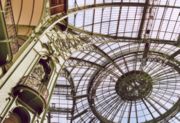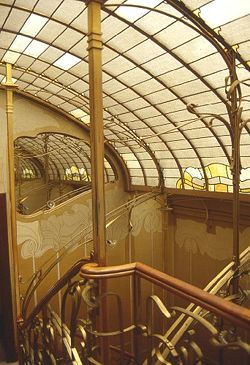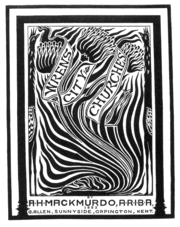Art Nouveau
2008/9 Schools Wikipedia Selection. Related subjects: Art
Art Nouveau ([aʁ nu vo], anglicised /ˈɑːt nuːvəu/) (French for 'new art') is an international style of art, architecture and design that peaked in popularity at the beginning of the 20th century (1880-1914) and is characterised by highly-stylised, flowing, curvilinear designs often incorporating floral and other plant-inspired motifs.
The name 'Art Nouveau' derived from the name of a shop in Paris, Maison de l'Art Nouveau, at the time run by Siegfried Bing, that showcased objects that followed this approach to design.
Art Nouveau was a movement that greatly influenced artists and designers and later progressed onto the De Stijl movement (from 1880-1905) and the German Bauhaus school (early 1920's-1930's). Unlike other styles of design, art nouveau was broad based enough to encompass a whole lifestyle: It was possible to live in an art nouveau house with art nouveau furniture, silverware, crockery, etc.
The style introduced by Bing was not an immediate success in Paris but rapidly spread to Nancy and to Belgium (especially Brussels) where Victor Horta and Henry Van de Velde would make major contributions in the field of architecture and design. In the United Kingdom Art Nouveau developed out of the Arts and Crafts Movement. The most important centre in Britain was Glasgow with the creations of Charles Rennie Mackintosh.
More localised terms for the phenomenon of self-consciously radical, somewhat reformist mannered chic that formed a prelude to 20th-century modernism include Jugendstil in Germany, Austria and many other countries, named after the avant-garde periodical Jugend ('Youth'), Młoda Polska ('Young Poland' style) in Poland, or skønvirke in Denmark, and Sezessionsstil ('Secessionism') in Vienna, where forward-looking artists and designers seceded from the mainstream salon exhibitions to exhibit on their own work in more congenial surroundings.
In Spain, the movement was centred in Barcelona and was known as modernisme, with the architect Antoni Gaudí as the most noteworthy practitioner. Art Nouveau was also a force in Central and Eastern Europe, with the influence of Alfons Mucha in Prague and Moravia (part of the modern Czech Republic) and Latvian Romanticism ( Riga, the capital of Latvia, is home to over 800 Art Nouveau buildings).
In Russia, the movement revolved around the art magazine Mir iskusstva ('World of Art'), which spawned the revolutionary Ballets Russes. In Italy, Stile Liberty was named for the London shop, Liberty & Co, which distributed modern design emanating from the Arts and Crafts movement, a sign both of the Art Nouveau's commercial aspect and the 'imported' character that it always retained in Italy.
The entrances to the Paris Métro designed by Hector Guimard in 1899 and 1900 are famous examples of Art Nouveau in Paris.
Although no significant artists in Australia are linked to the Art Nouveau movement, many buildings throughout Australia were designed in the Art Nouveau style. In Melbourne, the Victorian Arts Society, Milton House, Melbourne Sports Depot, Melbourne City Baths, Conservatory of Music and Melba Hall, Paston Building, and Empire Works Building all reflect the Art Nouveau style.
History of Art Nouveau
Art Nouveau climaxed in the years 1892 to 1902. One of the first Art nouveau paintings can be found at Roquetaillade castle (France). Viollet-le-Duc restored the castle in the 1850's, and even though his ideal was to create a Gothic revival, his fresque in the keep of the castle is a pure example of "pre" Art Nouveau style -- organic movement, colour and grace.
The first stirrings of an Art Nouveau "movement" can be recognised in the 1880s, in a handful of progressive designs such as the architect-designer Arthur Mackmurdo's book cover design for his essay on the city churches of Sir Christopher Wren, published in 1883. Some free-flowing wrought iron from the 1880s could also be adduced, or some flat floral textile designs, most of which owed some impetus to patterns of High Victorian design.
A high point in the evolution of Art Nouveau was the Exposition Universelle of 1900 in Paris, in which the 'modern style' triumphed in every medium. It probably reached its apogee, however, at the Esposizione Internazionale d'Arte Decorativa Moderna of 1902 in Turin, Italy, where designers exhibited from almost every European country where Art Nouveau flourished. Art Nouveau made use of many technological innovations of the late 19th century, especially the broad use of exposed iron and large, irregularly shaped pieces of glass in architecture. By the start of the First World War, however, the highly stylised nature of Art Nouveau design — which itself was expensive to produce — began to be dropped in favour of more streamlined, rectilinear modernism that was cheaper and thought to be more faithful to the rough, plain, industrial aesthetic that became Art Deco.
Character of Art Nouveau
Dynamic, undulating, and flowing, with curved 'whiplash' lines of syncopated rhythm, characterised much of Art Nouveau. Another feature is the use of hyperbolas and parabolas. Conventional mouldings seem to spring to life and 'grow' into plant-derived forms.
As an art movement it has affinities with the Pre-Raphaelites and the Symbolism movement, and artists like Aubrey Beardsley, Alphonse Mucha, Edward Burne-Jones, Gustav Klimt, and Jan Toorop could be classed in more than one of these styles. Unlike Symbolist painting, however, Art Nouveau has a distinctive visual look; and unlike the backward-looking Arts and Crafts Movement, Art Nouveau artists quickly used new materials, machined surfaces, and abstraction in the service of pure design.
Art Nouveau in architecture and interior design eschewed the eclectic revival styles of the Victorian era. Though Art Nouveau designers selected and 'modernised' some of the more abstract elements of Rococo style, such as flame and shell textures, they also advocated the use of highly stylised organic forms as a source of inspiration, expanding the 'natural' repertoire to embrace seaweed, grasses, and insects.
Japanese wood-block prints, with their curved lines, patterned surfaces, contrasting voids, and flatness of visual plane, also inspired Art Nouveau. Some line and curve patterns became graphic clichés that were later found in works of artists from all parts of the world.
Art Nouveau did not negate the machine as the Arts and Crafts Movement did, but used it to its advantage. For sculpture, the principal materials employed were glass and wrought iron, leading to sculptural qualities even in architecture.
Art Nouveau is considered a 'total' style, meaning that it encompasses a hierarchy of scales in design — architecture; interior design; decorative arts including jewelry, furniture, textiles, household silver and other utensils, and lighting; and the range of visual arts. (See Hierarchy of genres.)
Geographical scope of Art Nouveau


Centres of the style are:
|
|
Noted Art Nouveau practitioners
Architecture
- Émile André (1871-1933)
- Gavriil Baranovsky (1860-1920)
- Peter Behrens (1868-1940)
- Georges Biet (1868-1955)
- Paul Charbonnier (1865-1953)
- Gino Coppedè (1866-1927)
- Raimondo Tommaso D'Aronco (1857-1932)
- Mikhail Eisenstein (1867 - 1921)
- August Endel (1871-1925)
- Antoni Gaudi (1852-1926)
- Vladislav Gorodetsky (1863-1930))
- Hector Guimard (1867-1942)
- Gustaw Landau Gutenteger (1862-1924)
- Paul Hankar (1859-1901)
- Josef Hoffmann (1870-1956)
- Victor Horta (1861-1947)
- Dawid Lande (1868-1928)
- Ödön Lechner (1845-1914)
- Lev Kekushev (1862-1919)
- Charles Rennie Mackintosh (1868-1928)
- Rafael Masó (1880-1935)
- Marian Peretiatkovich (1872-1916)
- Fyodor Schechtel (1859-1926)
- Gustave Strauven (1878-1919)
- Louis Sullivan (1856-1924)
- László Székely (1877-1934)
- Eugène Vallin (1856-1922)
- Henry Van de Velde (1863-1957)
- Otto Wagner (1841-1918)
- William Walcot (1874-1943)
- Lucien Weissenburger (1860-1929)
Art, drawing, and graphics
- Aubrey Beardsley (1872-1898)
- Ivan Yakovlevich Bilibin (1876-1942)
- Walter Crane (1845-1915)
- Jules Cheret (1836-1932)
- Gaston Gerard (1878-1969)
- Gustav Klimt (1862-1918)
- Jozef Mehoffer (1869-1946)
- Alfons Mucha (1860-1939)
- Valentin Serov (1865-1911)
- Konstantin Somov (1869-1939)
- Henri de Toulouse-Lautrec (1864-1901)
- Janos Vaszary (1867-1939)
- Mikhail Vrubel (1856-1910)
- Stanisław Wyspiański (1869-1907)
Murals and mosaics
Furniture
|
Glassware and stained glass
Other decorative arts
|

